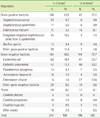Abstract
Background
A central venous catheter (CVC) is commonly used for administering chemotherapy to cancer patients. The institutional guideline of the Gyeongsang National University Hospital (GNUH) for blood culture analysis of indwelling CVC patients recommended 6 sets (2 from the periphery and 4 from each lumen). We analyzed the usefulness of this guideline, because complying with this recommendation requires an abundant amount of the sample and it is both inconvenient and expensive.
Methods
Adult patients (age: ≥18 yr old) who were admitted to the cancer center of GNUH between January 2011 and April 2012 were requested to have their blood culture analysis done. The positive rate, contamination rate, and distribution of microorganisms were compared according to the number of requested sets. The positive results of the stipulated 6 sets were analyzed.
Results
A total of 5,263 blood cultures were analyzed during the study period; of them, 74.4% were requests of 2 sets and 20.0% were requests of 6 sets. The positive rates in 2 set requests and 6 set requests were 8.0% and 14.3%, respectively (P<0.001). The requests for 6 sets were repeated about 5 times. All 6 sets showed positive in 16 cases (9.1%), whereas a part of the 6 sets was positive in 18 cases (10.3%).
Conclusions
Although the positive rate was relatively high in the 6 set-requested groups, they had to be repeatedly requested. Microbial growth in a part of the 6-set requests was observed in a very small proportion (10.3%) of the patients, indicating that the benefit of blood culture of 6 sets is very low.
Figures and Tables
Table 1
Positive rate and contamination rate in blood cultures analyzed with respect to the requested frequency of blood cultures in the cancer center

Table 2
Comparison of the isolates in blood cultures requested 1-2 times and 3-6 times in the cancer center

References
1. Chatzinikolaou I, Hanna H, Darouiche R, Samonis G, Tarrand J, Raad I. Prospective study of the value of quantitative culture of organisms from blood collected through central venous catheters in differentiating between contamination and bloodstream infection. J Clin Microbiol. 2006; 44:1834–1835.

2. CLSI. Clinical and laboratory standards institute. M47-A. Principles and procedures for blood cultures; approved guideline. Wayne, PA: Clinical and laboratory standards institute;2007.
3. Shin JH, Song SA, Kim MN, Lee NY, Kim EC, Kim SJ, et al. Comprehensive analysis of blood culture performed at nine university hospitals in Korea. Korean J Lab Med. 2011; 31:101–106.

4. Mylotte JM, Tayara A. Blood cultures: clinical aspects and controversies. Eur J Clin Microbiol Infect Dis. 2000; 19:157–163.

5. Lee A, Mirrett S, Reller LB, Weinstein MP. Detection of bloodstream infections in adults: how many blood cultures are needed? J Clin Microbiol. 2007; 45:3546–3548.

6. Shin JH, Song SA, Kim MN, Kim S. Nationwide survey of blood culture performance regarding skin disinfection, blood collection and laboratory procedures. Korean J Clin Microbiol. 2011; 14:91–96.

7. Robinson JL. Sensitivity of a blood culture drawn through a single lumen of a multilumen, long-term, indwelling, central venous catheter in pediatric oncology patients. J Pediatr Hematol Oncol. 2002; 24:72–74.

8. Velasco E, Byington R, Martins CA, Schirmer M, Dias LM, Gonçalves VM. Prospective evaluation of the epidemiology, microbiology, and outcome of bloodstream infections in hematologic patients in a single cancer center. Eur J Clin Microbiol Infect Dis. 2003; 22:137–143.

9. Maschmeyer G, Noskin GA, Ribaud P, Sepkowitz KA. Changing patterns of infections and antimicrobial susceptibilities. Oncology. 2000; 14:9–16.
10. Rolston KV. The Infectious Diseases Society of America 2002 guidelines for the use of antimicrobial agents in patients with cancer and neutropenia: salient features and comments. Clin Infect Dis. 2004; 39:Suppl 1. S44–S48.





 PDF
PDF ePub
ePub Citation
Citation Print
Print




 XML Download
XML Download